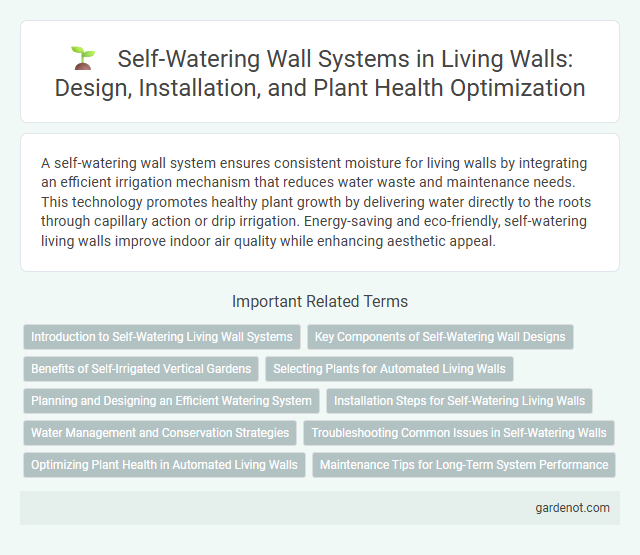A self-watering wall system ensures consistent moisture for living walls by integrating an efficient irrigation mechanism that reduces water waste and maintenance needs. This technology promotes healthy plant growth by delivering water directly to the roots through capillary action or drip irrigation. Energy-saving and eco-friendly, self-watering living walls improve indoor air quality while enhancing aesthetic appeal.
Introduction to Self-Watering Living Wall Systems
Self-watering living wall systems integrate automated irrigation technology that delivers consistent moisture directly to plant roots, reducing water waste by up to 40%. These systems feature built-in reservoirs and capillary action, promoting healthier plant growth while minimizing maintenance requirements. Ideal for both indoor and outdoor applications, self-watering walls enhance air quality and aesthetic appeal with sustainable, efficient plant hydration.
Key Components of Self-Watering Wall Designs
Self-watering wall systems incorporate a reservoir, wicking material, and automated irrigation components to ensure consistent moisture delivery. The reservoir stores water which is gradually absorbed by the wicking layer, maintaining optimal soil hydration without overwatering. Integrated sensors and drip irrigation regulate water distribution, promoting plant health and reducing maintenance requirements.
Benefits of Self-Irrigated Vertical Gardens
Self-watering wall systems in vertical gardens reduce water waste by utilizing efficient irrigation technology, ensuring consistent moisture without overwatering. These systems promote plant health and growth by maintaining optimal hydration levels, leading to lush, vibrant greenery. Energy savings and reduced maintenance time make self-irrigated vertical gardens an eco-friendly and cost-effective solution for urban landscaping.
Selecting Plants for Automated Living Walls
Selecting plants for automated living walls requires careful consideration of species that thrive in consistent moisture environments provided by self-watering wall systems. Ideal plants include moisture-loving varieties such as ferns, philodendrons, and pothos, which adapt well to stable hydration without waterlogging. Incorporating drought-tolerant succulents like echeveria or sedum enhances system efficiency by reducing water demand while maintaining visual appeal.
Planning and Designing an Efficient Watering System
Planning and designing an efficient self-watering wall system involves selecting appropriate water distribution mechanisms such as drip irrigation or capillary mats to ensure uniform moisture levels. Integrating sensors and automated timers optimizes water usage by adjusting irrigation based on real-time soil moisture data and environmental conditions. Proper layering of growth mediums and waterproof backing prevents water damage while promoting healthy plant root growth in vertical gardens.
Installation Steps for Self-Watering Living Walls
Installation of a self-watering living wall system begins with securely mounting the frame to a sturdy, vertical surface capable of supporting the weight of saturated plants and soil. Next, install the integrated irrigation system, ensuring the water reservoir, pump, and drip lines are properly connected for consistent moisture delivery. Finally, insert the planting modules filled with lightweight, water-retentive substrates and native or adapted plant species, then test the irrigation system to confirm even water distribution and drainage.
Water Management and Conservation Strategies
Self-watering living walls incorporate advanced water management systems that recycle and distribute moisture efficiently, minimizing water waste while maintaining optimal plant hydration. These systems utilize drip irrigation combined with moisture sensors to adapt water delivery based on environmental conditions, promoting sustainable water conservation. By integrating rainwater harvesting and automatic drainage, self-watering walls significantly reduce reliance on external water sources, enhancing ecological sustainability in urban green installations.
Troubleshooting Common Issues in Self-Watering Walls
Self-watering wall systems often encounter issues such as clogged drip lines, uneven water distribution, and root rot caused by overwatering. Regular inspection of the irrigation components, cleaning of filters, and adjusting water flow prevent blockages and ensure consistent moisture levels. Monitoring plant health and soil moisture sensors helps identify problems early, improving system efficiency and plant vitality.
Optimizing Plant Health in Automated Living Walls
Self-watering wall systems in automated living walls optimize plant health by maintaining consistent moisture levels, reducing water stress and promoting robust growth. Advanced sensors monitor soil humidity and nutrient levels, triggering precise irrigation that prevents over- or under-watering. These systems enhance sustainability by minimizing water waste while supporting diverse plant species in vertical garden installations.
Maintenance Tips for Long-Term System Performance
Regularly inspect the self-watering wall system's reservoir and irrigation lines to prevent clogs and ensure consistent water flow. Clean filters monthly and remove any debris or algae buildup to maintain optimal water distribution. Periodic adjustment of moisture sensors and timely replacement of worn components significantly enhance the system's long-term performance and plant health.
Self-watering wall system Infographic

 gardenot.com
gardenot.com